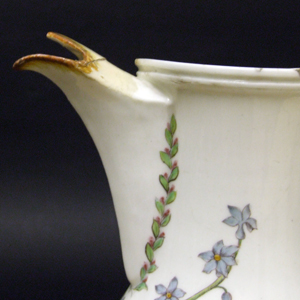
CAPODIMONTE c.1755 Italian Soft-Paste Porcelain
An 18th Century Capodimonte Soft-Paste Porcelain, Carlos III Period c.1755. Painted with Laurels, the Body Painted with a Bouquet of a Carnation, Rose, Tulip and other Flowers and Three Scattered Ombrierte Insects. The Base with a Fleur-de-Lys Mark.
SOLD
- Condition
- The handle has been broken into three separate sections.
- Size
- Diameter : 22.8 cm (9 inches).
- Provenance
- N/A
- Stock number
- 21821
Information
Capodimonte Porcelain :
The Capodimonte porcelain factory started in 1743 following Maria Amalia Walburga of Sassonia’s (daughter of Federico Augusto King of Poland and grand-daughter of August the Great – creator of the porcelain factory in Meissen), marriage to Carlo III di Borbone (King of Spain from 1716 to 1788). The couple decided to build a porcelain factory in Naples, early progress was made between 1743 to 1745. Detailed record are preserved in the Neapolitan State Archives giving explicit details of the painted designs and forms used. The soft-paste porcelain used at Capodimonte is usually highly translucent with a pink or yellow tinge to it. The close fitting glaze is normally quite lustrous but sometimes it is fired rather matt. This might be deliberate as the surface takes the painted decoration very well. The factory has earned the reputation as the foremost of all 18th century Italian porcelain factories and yet it closed or rather relocated in 1759. Arthur Lane writes in `Italian Porcelain` "Three ships left Alicante in October 1759, laden with 44 of the Capodimonte staff, their families, and 88 tons of equipment (including 4 3/4 tones of porcelain-paste). A new factory, built in the grounds of the Buen Retiro Palace on the eastern outskirts of Madrid, was ready by May 1760" (Italian Porcelain with a note on Buen Retiro, Arthur Lane, Faber and Faber, 1954) page 52.
18 ° Secolo Capodimonte Porcellana.